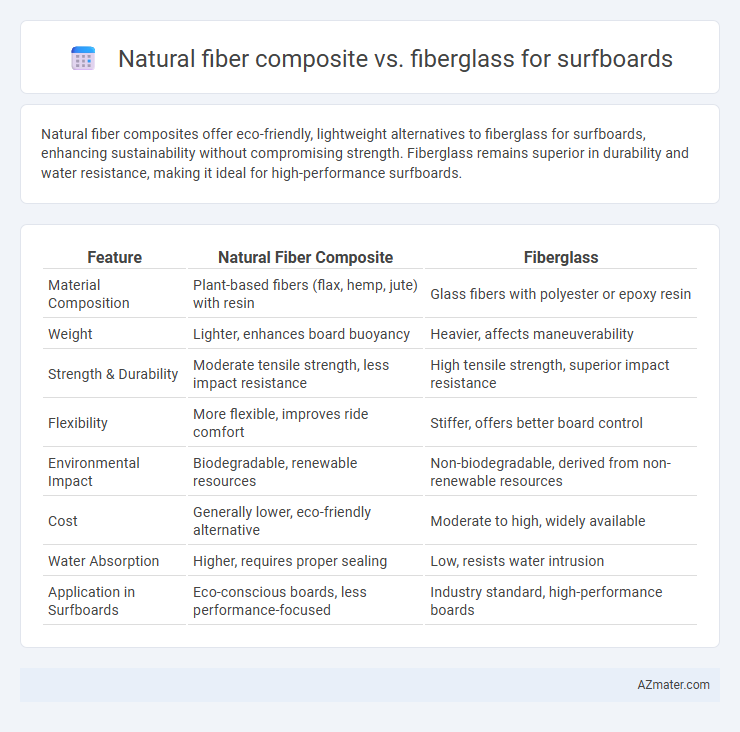Natural fiber composites offer eco-friendly, lightweight alternatives to fiberglass for surfboards, enhancing sustainability without compromising strength. Fiberglass remains superior in durability and water resistance, making it ideal for high-performance surfboards.
Table of Comparison
| Feature | Natural Fiber Composite | Fiberglass |
|---|---|---|
| Material Composition | Plant-based fibers (flax, hemp, jute) with resin | Glass fibers with polyester or epoxy resin |
| Weight | Lighter, enhances board buoyancy | Heavier, affects maneuverability |
| Strength & Durability | Moderate tensile strength, less impact resistance | High tensile strength, superior impact resistance |
| Flexibility | More flexible, improves ride comfort | Stiffer, offers better board control |
| Environmental Impact | Biodegradable, renewable resources | Non-biodegradable, derived from non-renewable resources |
| Cost | Generally lower, eco-friendly alternative | Moderate to high, widely available |
| Water Absorption | Higher, requires proper sealing | Low, resists water intrusion |
| Application in Surfboards | Eco-conscious boards, less performance-focused | Industry standard, high-performance boards |
Introduction to Surfboard Materials
Natural fiber composites, such as hemp, flax, and jute reinforced with bio-resins, offer a sustainable alternative to traditional fiberglass used in surfboard construction. These eco-friendly materials provide comparable strength-to-weight ratios while reducing environmental impact through biodegradability and lower carbon footprints. Fiberglass remains popular for its durability and performance consistency but is increasingly challenged by the demand for greener surfboard options leveraging natural fibers.
What Are Natural Fiber Composites?
Natural fiber composites are engineered materials that combine a polymer matrix with natural fibers such as flax, hemp, or jute, offering a sustainable alternative to traditional fiberglass in surfboard construction. These composites provide improved environmental benefits by reducing carbon footprint and enhancing biodegradability while maintaining comparable strength and flexibility. Their lightweight and impact-resistant properties make natural fiber composites increasingly popular for eco-friendly surfing equipment.
Understanding Fiberglass in Surfboard Construction
Fiberglass is a key material in surfboard construction due to its high strength-to-weight ratio and excellent durability, providing structural support and resistance to water damage. This composite typically consists of woven glass fibers embedded in a resin matrix, creating a rigid and lightweight shell that enhances the board's performance and longevity. Understanding fiberglass's properties helps in comparing it to natural fiber composites, which offer sustainability but may vary in strength and water resistance.
Comparative Strength and Flexibility
Natural fiber composites such as hemp or flax offer superior flexibility compared to fiberglass, providing enhanced shock absorption and reduced brittleness, which can improve surfboard maneuverability. Fiberglass is known for its high tensile strength and stiffness, delivering greater durability and structural integrity under heavy stress, making it ideal for high-performance surfboards demanding rigidity. The natural fiber composite's strength-to-weight ratio is competitive but generally lower than fiberglass, though its environmental benefits and sufficient mechanical properties make it a viable alternative for surfers prioritizing sustainability and moderate performance.
Weight and Performance Differences
Natural fiber composites, such as flax or hemp, offer a significant weight reduction compared to traditional fiberglass surfboards, improving buoyancy and maneuverability. These composites provide a lower environmental impact while maintaining competitive strength and flexural properties, contributing to a responsive ride. Fiberglass, while heavier, delivers higher stiffness and durability, enhancing performance in powerful wave conditions but often sacrificing lightweight agility.
Environmental Impact and Sustainability
Natural fiber composites, made from materials such as flax, hemp, or jute, offer significantly lower carbon footprints and enhanced biodegradability compared to traditional fiberglass surfboards, which rely on non-renewable petroleum-based resins and glass fibers. The production of natural fiber composites consumes less energy and generates fewer hazardous emissions, promoting sustainable surfboard manufacturing practices. Furthermore, natural fibers contribute to reducing ocean pollution by minimizing microplastic release and supporting circular economy principles through compostable end-of-life disposal options.
Durability and Longevity
Natural fiber composites exhibit lower durability and reduced longevity compared to fiberglass when used in surfboard construction, as fiberglass offers superior resistance to impact, water absorption, and UV degradation. The inherent moisture absorption in natural fibers leads to increased vulnerability to delamination and structural weakening over time. Fiberglass surfboards maintain their performance and structural integrity significantly longer due to enhanced toughness and hydrophobic properties.
Cost Analysis: Natural Fiber vs. Fiberglass
Natural fiber composites, such as flax or hemp, generally offer a lower material cost compared to fiberglass, especially when sourced locally or sustainably. Fiberglass materials tend to have higher durability and performance, but their price per square meter is typically 20-30% higher than natural fibers. Considering lifecycle costs, natural fiber composites may reduce environmental expenses but could increase maintenance and replacement frequency, affecting long-term cost-effectiveness.
Rider Experience and Feedback
Natural fiber composites in surfboards provide a lightweight and eco-friendly alternative to fiberglass, offering enhanced flexibility and a more natural feel on the water. Riders often report improved vibration damping and a smoother ride, which contributes to better responsiveness during turns and maneuvers. Feedback highlights that while natural fibers may slightly reduce durability compared to fiberglass, the increased comfort and environmental benefits are valued by eco-conscious surfers.
Future Trends in Surfboard Material Innovation
Natural fiber composites in surfboard manufacturing are gaining traction due to their eco-friendly properties, biodegradability, and reduced carbon footprint compared to traditional fiberglass. Advances in bio-resin technology and hybrid composite structures enhance the durability and performance of natural fiber boards, meeting industry demands for sustainability without compromising strength. Emerging trends prioritize recyclable materials and closed-loop production systems, positioning natural fiber composites as a key innovation in the future of surfboard materials.

Infographic: Natural fiber composite vs Fiberglass for Surfboard
 azmater.com
azmater.com